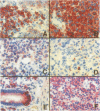Abstract
AIMS--To characterise a new mouse monoclonal antibody, VS38, which recognises an intracytoplasmic antigen of 64 kilodaltons present in normal and neoplastic plasma cells; and to establish its value as a diagnostic reagent for routine pathological practice. METHODS--A range of normal and neoplastic tissue sections, both frozen and routinely fixed, were immunostained, using the microwave method of antigen retrieval for routinely fixed specimens. The antibody was also tested on blood and bone marrow specimens and a range of human cell lines. The molecular weight of the antigen recognised by the antibody was obtained by western blot analysis. FACS analysis was used to demonstrate the cellular location of the antigen and its presence on tonsil cell suspensions and myeloma cases. RESULTS--VS38 recognised normal and neoplastic plasma cells in all of the tissues, including all routinely fixed plasma cell neoplasms tested. The antibody also weakly stained epithelial elements within the tissue but was absent from haemopoietic cells of other lineages. CONCLUSION--Antibody VS38 is of potential value in identifying myeloma or plasmacytoma in bone marrow or other tissues. It differentiates lymphoplasmacytoid lymphoma from lymphocytic and follicular lymphoma. It also subdivides large cell lymphomas into two groups which may be a more reliable method of separating these tumours than morphology alone.
Full text
PDF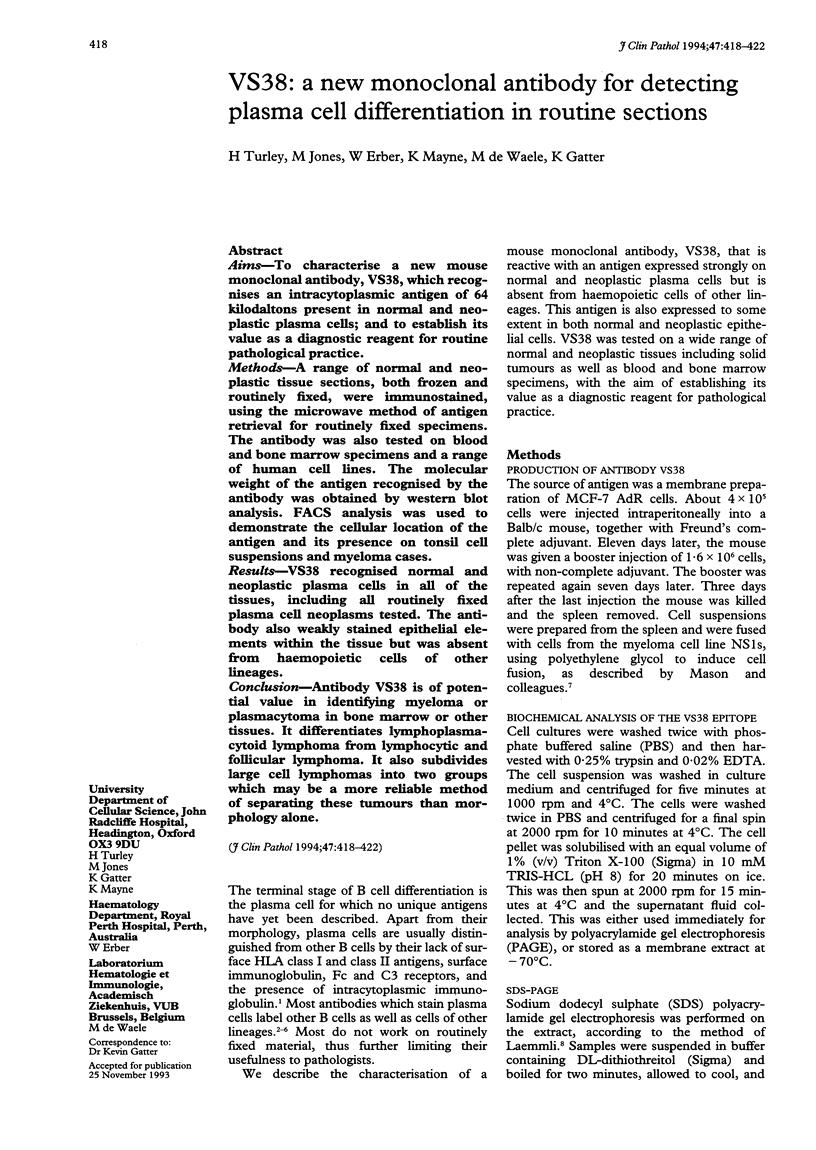
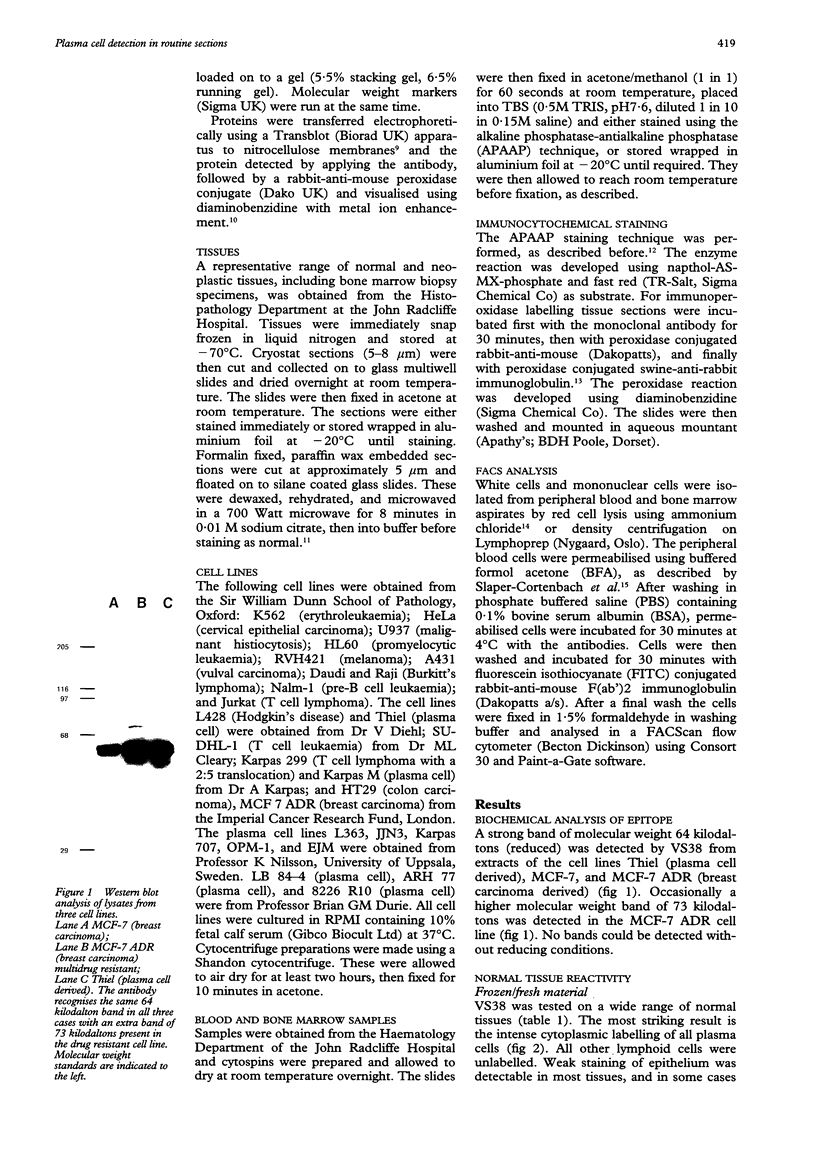
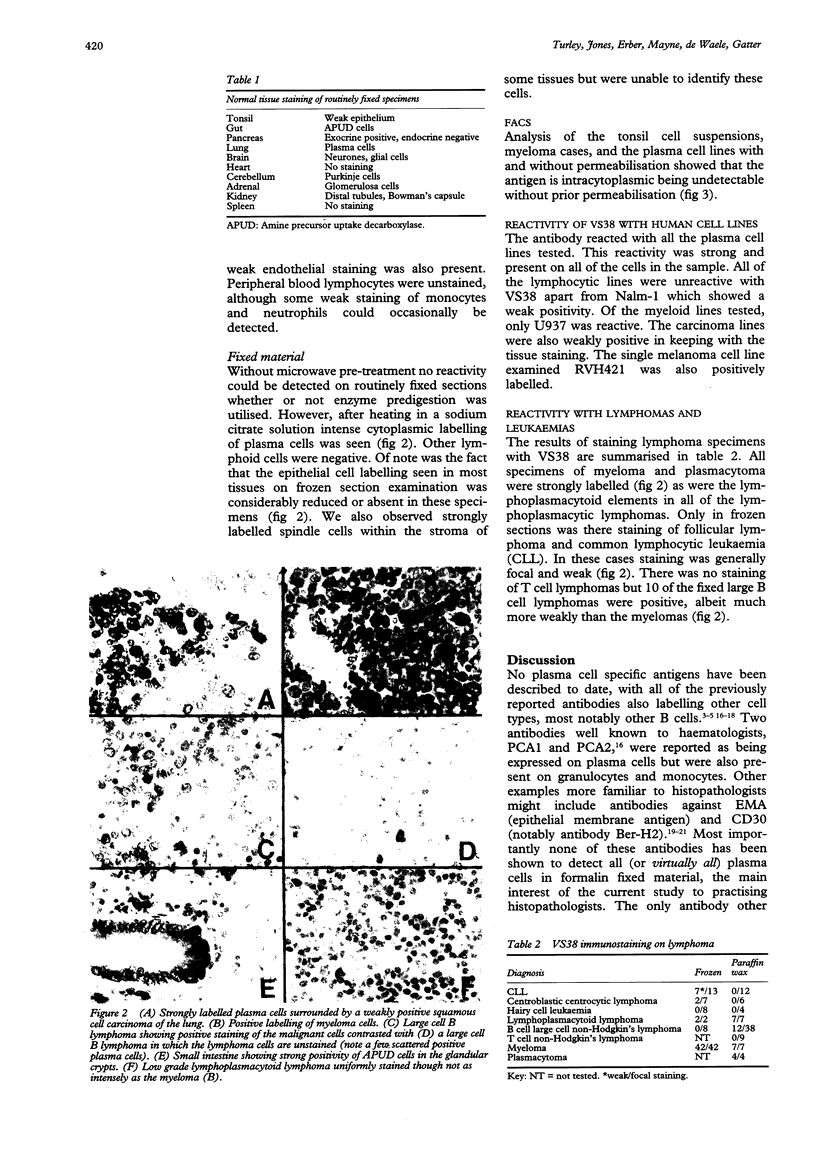
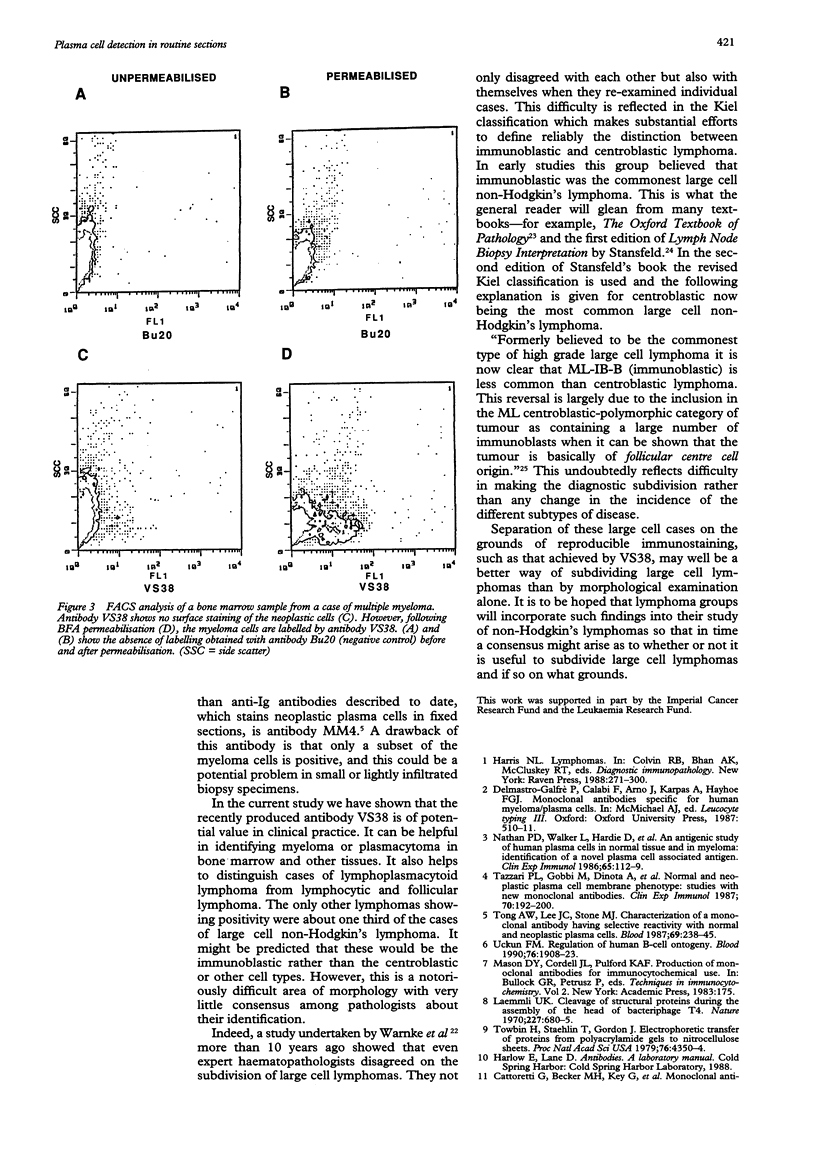

Images in this article
Selected References
These references are in PubMed. This may not be the complete list of references from this article.
- Anderson K. C., Park E. K., Bates M. P., Leonard R. C., Hardy R., Schlossman S. F., Nadler L. M. Antigens on human plasma cells identified by monoclonal antibodies. J Immunol. 1983 Mar;130(3):1132–1138. [PubMed] [Google Scholar]
- Cordell J. L., Falini B., Erber W. N., Ghosh A. K., Abdulaziz Z., MacDonald S., Pulford K. A., Stein H., Mason D. Y. Immunoenzymatic labeling of monoclonal antibodies using immune complexes of alkaline phosphatase and monoclonal anti-alkaline phosphatase (APAAP complexes). J Histochem Cytochem. 1984 Feb;32(2):219–229. doi: 10.1177/32.2.6198355. [DOI] [PubMed] [Google Scholar]
- Cordell J., Richardson T. C., Pulford K. A., Ghosh A. K., Gatter K. C., Heyderman E., Mason D. Y. Production of monoclonal antibodies against human epithelial membrane antigen for use in diagnostic immunocytochemistry. Br J Cancer. 1985 Sep;52(3):347–354. doi: 10.1038/bjc.1985.200. [DOI] [PMC free article] [PubMed] [Google Scholar]
- Heyderman E., Strudley I., Powell G., Richardson T. C., Cordell J. L., Mason D. Y. A new monoclonal antibody to epithelial membrane antigen (EMA)-E29. A comparison of its immunocytochemical reactivity with polyclonal anti-EMA antibodies and with another monoclonal antibody, HMFG-2. Br J Cancer. 1985 Sep;52(3):355–361. doi: 10.1038/bjc.1985.201. [DOI] [PMC free article] [PubMed] [Google Scholar]
- Laemmli U. K. Cleavage of structural proteins during the assembly of the head of bacteriophage T4. Nature. 1970 Aug 15;227(5259):680–685. doi: 10.1038/227680a0. [DOI] [PubMed] [Google Scholar]
- Linden M. D., Fishleder A. J., Tubbs R. R., Park H. Immunophenotypic spectrum of plasma cell leukemia. Cancer. 1989 Mar 1;63(5):859–862. doi: 10.1002/1097-0142(19890301)63:5<859::aid-cncr2820630511>3.0.co;2-b. [DOI] [PubMed] [Google Scholar]
- Nathan P. D., Walker L., Hardie D., Richardson P., Khan M., Johnson G. D., Ling N. R. An antigenic study of human plasma cells in normal tissue and in myeloma: identification of a novel plasma cell associated antigen. Clin Exp Immunol. 1986 Jul;65(1):112–119. [PMC free article] [PubMed] [Google Scholar]
- San Miguel J. F., González M., Gascón A., Moro M. J., Hernández J. M., Ortega F., Jimenez R., Guerras L., Romero M., Casanova F. Immunophenotypic heterogeneity of multiple myeloma: influence on the biology and clinical course of the disease. Castellano-Leones (Spain) Cooperative Group for the Study of Monoclonal Gammopathies. Br J Haematol. 1991 Feb;77(2):185–190. doi: 10.1111/j.1365-2141.1991.tb07975.x. [DOI] [PubMed] [Google Scholar]
- Schwarting R., Gerdes J., Dürkop H., Falini B., Pileri S., Stein H. BER-H2: a new anti-Ki-1 (CD30) monoclonal antibody directed at a formol-resistant epitope. Blood. 1989 Oct;74(5):1678–1689. [PubMed] [Google Scholar]
- Slaper-Cortenbach I. C., Admiraal L. G., Kerr J. M., van Leeuwen E. F., von dem Borne A. E., Tetteroo P. A. Flow-cytometric detection of terminal deoxynucleotidyl transferase and other intracellular antigens in combination with membrane antigens in acute lymphatic leukemias. Blood. 1988 Nov;72(5):1639–1644. [PubMed] [Google Scholar]
- Tazzari P. L., Gobbi M., Dinota A., Bontadini A., Grassi G., Cerato C., Cavo M., Pileri S., Caligaris-Cappio F., Tura S. Normal and neoplastic plasma cell membrane phenotype: studies with new monoclonal antibodies. Clin Exp Immunol. 1987 Oct;70(1):192–200. [PMC free article] [PubMed] [Google Scholar]
- Tong A. W., Lee J. C., Stone M. J. Characterization of a monoclonal antibody having selective reactivity with normal and neoplastic plasma cells. Blood. 1987 Jan;69(1):238–245. [PubMed] [Google Scholar]
- Towbin H., Staehelin T., Gordon J. Electrophoretic transfer of proteins from polyacrylamide gels to nitrocellulose sheets: procedure and some applications. Proc Natl Acad Sci U S A. 1979 Sep;76(9):4350–4354. doi: 10.1073/pnas.76.9.4350. [DOI] [PMC free article] [PubMed] [Google Scholar]
- Uckun F. M. Regulation of human B-cell ontogeny. Blood. 1990 Nov 15;76(10):1908–1923. [PubMed] [Google Scholar]
- Warnke R. A., Strauchen J. A., Burke J. S., Hoppe R. T., Campbell B. A., Dorfman R. F. Morphologic types of diffuse large-cell lymphoma. Cancer. 1982 Aug 15;50(4):690–695. doi: 10.1002/1097-0142(19820815)50:4<690::aid-cncr2820500412>3.0.co;2-l. [DOI] [PubMed] [Google Scholar]




